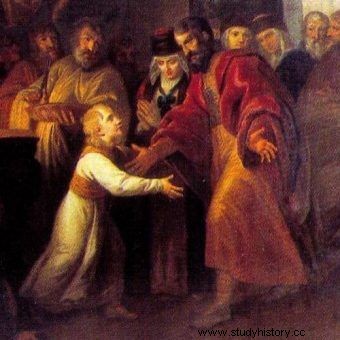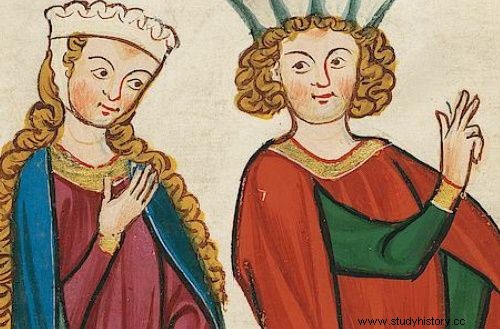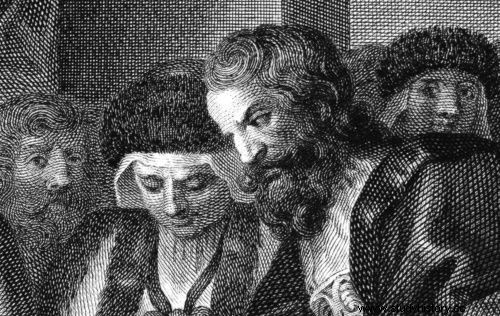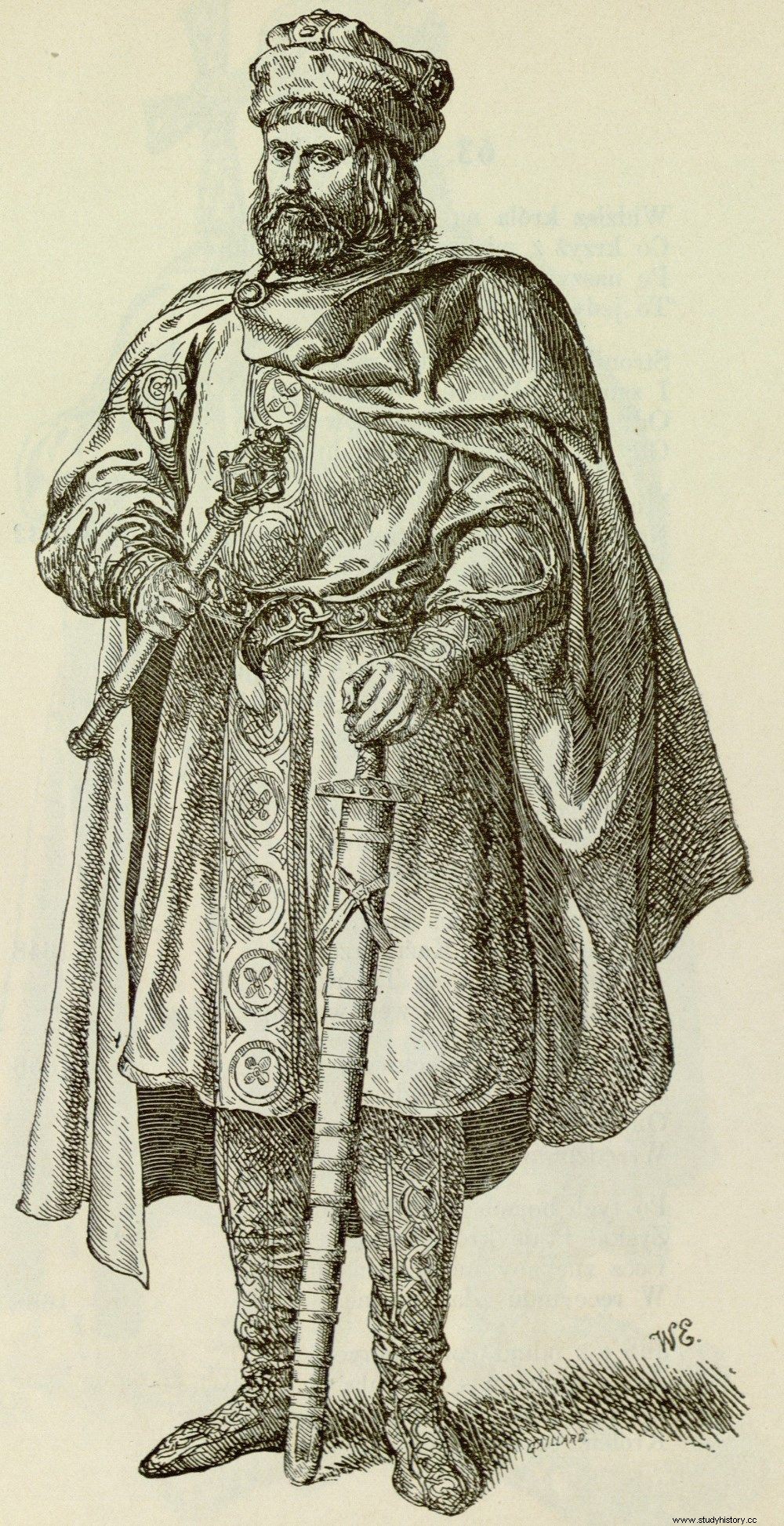Historians more and more boldly admit that Gall Anonim was not a fairy tale writer at all, and before Mieszko I the not-so-legendary Siemowit, Lestek and Siemomysł ruled. It is worth taking one more step back. After all, behind every strong man there was at least an equally powerful woman.
Only seemingly nothing can be said about Mieszko I's mother and Siemomysła's wife. The author of the first Polish chronicle devoted little less attention to it than to the ruler himself. The parents together perform in the famous feast scene organized on the occasion of the haircut of the seven-year-old heir to the throne.

Mieszko's haircut. Graphics from the Vilnius Album of Jan Kazimierz Wilczyński.
Gall Anonim reports that it was during this feast that the prince heard the amazing news that his son, who was blind from a child, regained his sight. The report seemed utterly improbable to him. To make sure it wasn't a sick joke, sent to the child the only person he trusted immensely:his spouse.
"The mother, having arisen from the feast, went to the boy and put an end to the father's uncertainty, showing all the guests the boy who was already watching" - we read in the Polish Chronicle . The very story of regaining sight after the symbolic seven years of darkness has, of course, an allegory dimension.

One can guess that Siemomysła's wife had an unprecedented influence on the government.
It is explained by the author himself, emphasizing that little Mieszko regained his sight as much as Poland regained it as a result of adopting Christianity during his reign. It is safe to assume that Mieszko was never blind. However, this does not mean that you should throw this whole story in the trash.
A chronicler who hated women…
The very fact that the prince's wife was mentioned in it is of great importance. Gall Anonymous was, without trying on, an exceptional misogynist. Throughout his work, he mentioned a total of about twenty women. Only three (yes, three!) Were mentioned by name.

The parents of Mieszko I. Graphics from the Vilnius Album of Jan Kazimierz Wilczyński.
In short, in the opinion of this chronicler, there was no place for the other sex in history. If he made an exception for Mieszko's mother, then perhaps there was indeed a tradition about the existence of such a figure and its influence on governments.
After all, we are dealing here with a lady who participates in a court feast with men, interacts directly with her husband, and in addition - pushes all Siemomysła's other partners into the shadows. The Piasts of this era undoubtedly practiced polygamy and Gall Anonymous was fully aware of this. In the next chapter he wrote that Mieszko "used to take seven wives according to the custom." In the case of Siemomysło, however, such a custom is out of the question. The chronicler mentions only one, clearly distinguished spouse.
Women's beginnings of Poland
Information about the duchess can of course be interpreted differently. However, one cannot escape the conclusion that, in the light of tradition, women had an enormous influence on the life and achievements of Mieszko. First my mother, then my wife, Dobrawa. In Gall Anonymus, the story of no other ruler was so "feminized." Fortunately, you don't have to limit yourself to Gall at all.

Prince Siemomysł in the nineteenth-century illustration from Józef Chociszewski's "National Reading".
The lack of written sources does not allow to determine exactly where Siemomysła's wife came from. It was probably one of the neighboring states which, before Mieszko's baptism, were part of the Piast domain. It is possible that our heroine was the daughter of the leader of Nadobrzanie conquered in the middle of the 10th century, or that she came from one of the Pomeranian tribes. The latter hypothesis was put forward by genealogists years ago.
Paradoxically, much more can be said about the name of the duchess. So far known only as "N.N." finally he can regain his true name.
Name discovered a thousand years later
Research from the Poznań historian Rafał Prinke, recently supported by Grzegorz Pac, shows that the surname of the ruler was Świętosław.
For years it has been called like this - as a result of what seems to be an unfortunate mistake - Mieszko's daughter married to the Danish king Sven Widłbeard. Sources, however, only say that Widłobrody 'wife called Świętosławą one of her daughters. There is no question that she would also bear that name herself. Meanwhile, the customs prevailing in Scandinavia forbade giving children the names of living ancestors, let alone their own names.
If the Slavic name of Świętosława came to Denmark, it must have been worn not by the princess herself, but by one of her distinguished ancestors. It could not be the mother of the Scandinavian queen (this was Dobrawa or Oda). So the grandmother comes naturally to me.
The Duchess of Greater Poland and the wife of Siemomysł, Świętosław.
Sources:
The article is based on the literature and materials collected by the author during the work on the book "Iron Ladies. The Women Who Built Poland ” . Find out more by clicking HERE . Selected bibliographic items below:
- M. Dembińska, The model of a Slavic woman in the chronicles of Gallus Anonymus, Cosmas and Nestor [in:] Medieval and Old Polish culture. Studies offered to Aleksander Gieysztor in the 50th anniversary of his scientific work , ed. D. Gawinowa, Warsaw 1991.
- M. Hare, Cnut and Lotharingia. Two Notes , 'Anglo-Saxon England', vol. 29 (2000).
- Jasiński K., Pedigree of the first Piasts , Poznań 2004.
- S. Kętrzyński, Poland in the 10th – 11th centuries , Warsaw 1961.
- M. Matla-Kozłowska, Did the woman deserve the interest of vintage writers? Considerations on the basis of the oldest Polish and Czech journalism [in:] Hominem quaerere. The man in the historical source , ed. S. Rosik, P. Wiszewski, Wrocław 2008.
- K. Mosingiewicz, Name as a source in genealogical research [in:] Genealogy - methodological problems in research on Polish medieval society against a comparative background , ed. J. Hertel, Toruń 1982.
- G. Pac, Women in the Piast dynasty. The social role of Piast wives and daughters until the mid-12th century - a comparative study , Toruń 2013.
- R.T. Prinke, Świętosława, Sygryda, Gunhilda. The identity of Mieszko I's daughter and her Scandinavian relationships , "Historical Annals", vol. 60 (2004).
- P. Wiszewski, Domus Bolezlai. In search of the Piast dynastic tradition (until around 1138) , Wrocław 2008.
